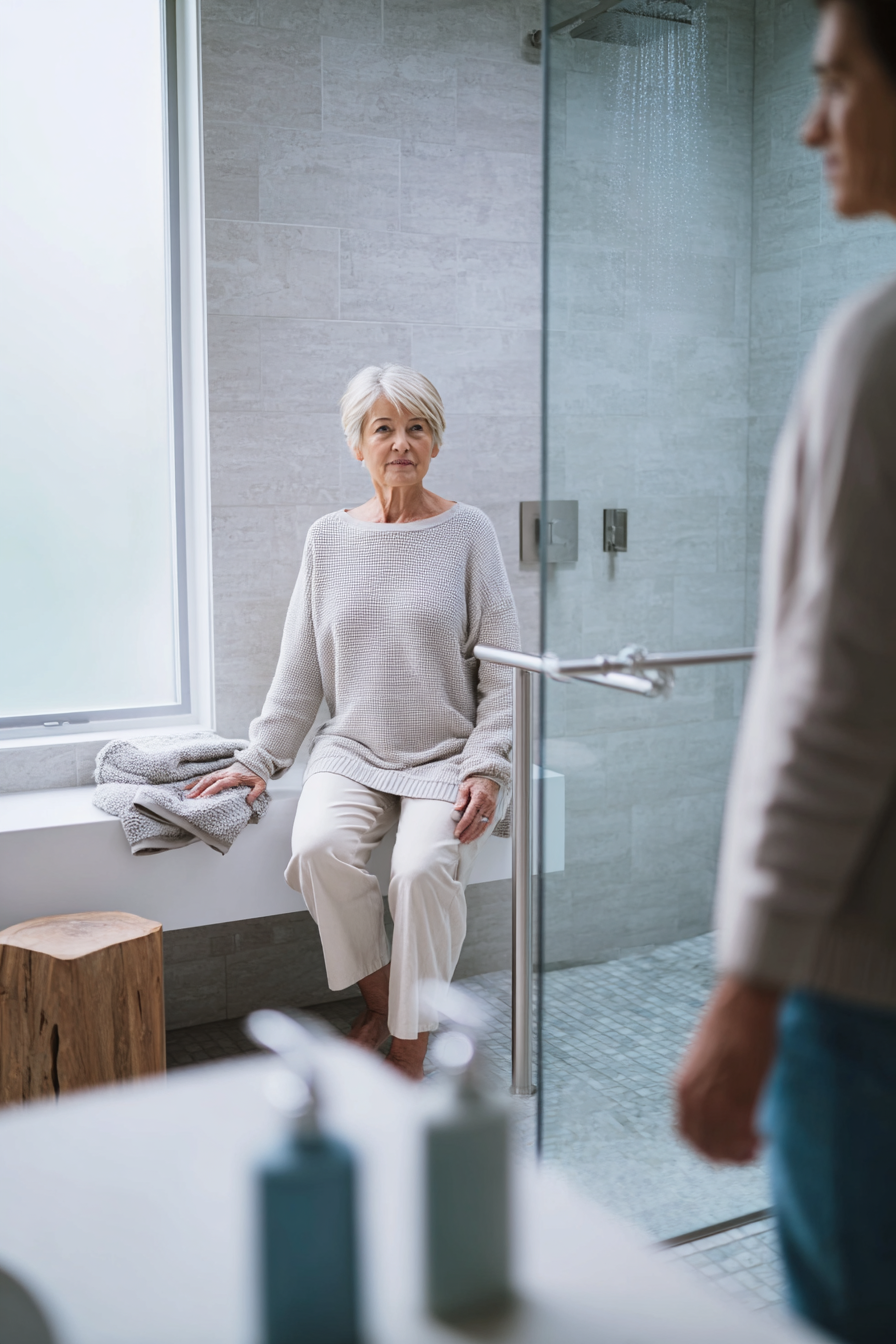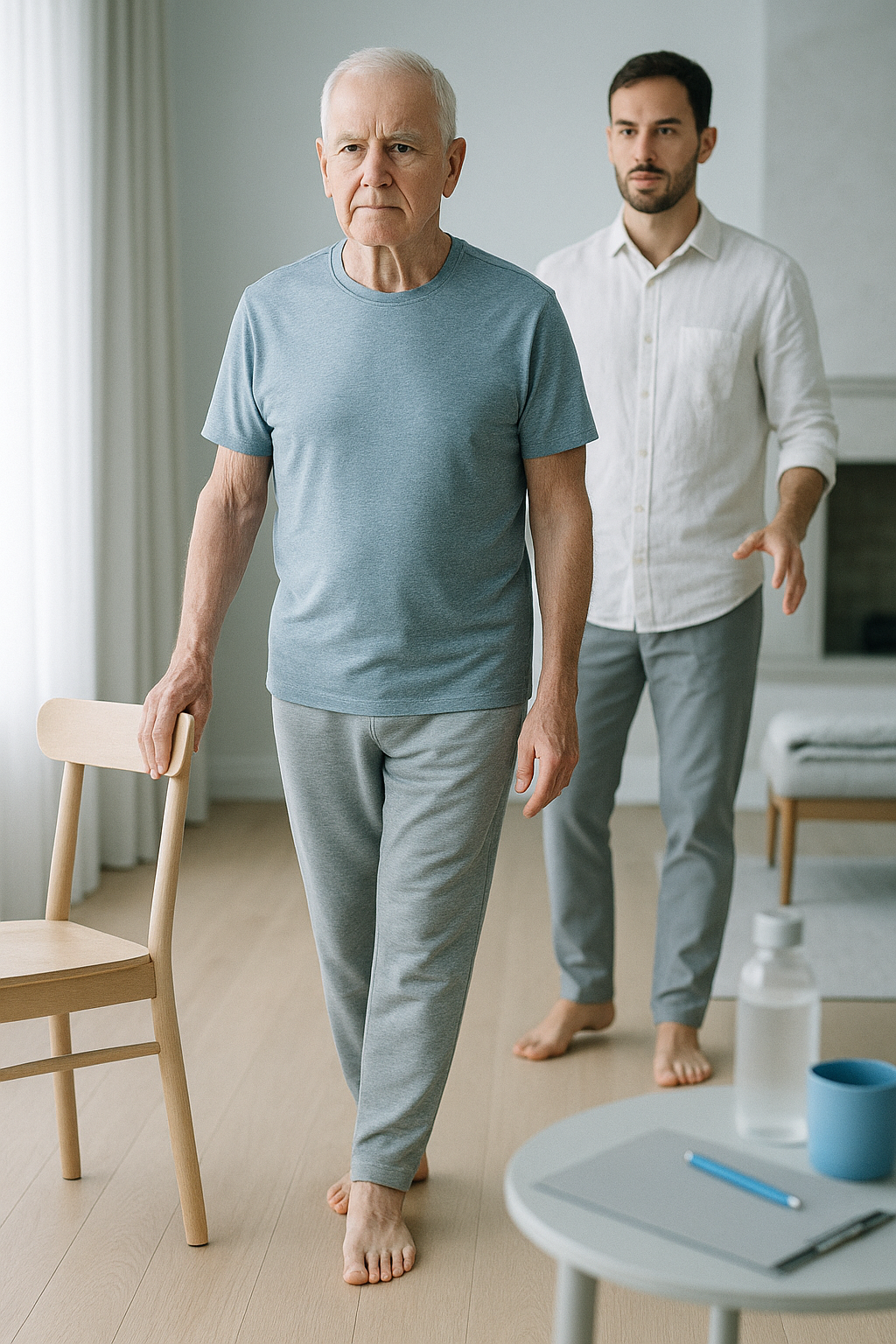
Share
Bathroom Safety Tips for Elderly in Canada
For Canadian seniors who want to age in place, the bathroom is both essential and risky. Wet floors, tight spaces, and frequent transfers make this room the leading site of falls among older adults. Each year, 20-30% of Canadian seniors experience at least one fall, and bathrooms account for a significant share of these incidents. Falls cause 85% of seniors' injury-related hospitalizations and 95% of hip fractures, with direct healthcare costs reaching approximately $2 billion annually in Canada.
This guide delivers practical, affordable bathroom safety tips for elderly Canadians, family caregivers, and home-care professionals. You will learn how to identify common hazards, prioritize low-cost fixes, install grab bars correctly, choose effective non-slip surfaces, and select emergency response devices. The goal is straightforward: reduce fall risk and help seniors maintain independence at home.
Whether you live in a compact apartment, an older house with narrow doorways, or a modern accessible space, these evidence-based strategies will help you create a safer bathroom environment.
If you are thinking about these upgrades as part of a broader plan to stay in your home longer, you may also find it helpful to read about how federal supports like the Age Well at Home Initiative and other community services fit into aging-in-place planning.
Common Bathroom Hazards for Seniors
Wet and slippery floors top the list of bathroom risks. Water from showers, condensation, and tracked-in moisture create treacherous surfaces. Loose bath mats slide underfoot, and high bathtub thresholds demand balance and leg strength that many seniors no longer have.
Poor lighting leaves shadows and hides depth changes, while cluttered counters and floors force awkward navigation. Hard-to-reach shelves encourage bending and overreaching. Older adults with reduced balance, muscle strength, or vision face compounded risk from each of these hazards. Medications that cause dizziness or drowsiness add another layer of danger.
In Canada, approximately 500,000 people - most of them seniors - live with vision loss, making dim or poorly lit bathrooms especially hazardous. Small bathrooms common in older apartments and homes limit maneuvering space and increase the chance of bumping into fixtures. During winter months, tracked-in mud, salt, and melting snow raise the risk of slips near bathroom entry points.
Addressing these environmental risks forms the foundation of effective bathroom safety for seniors. For a broader look at why older adults fall and how to reduce risk throughout the home and community, see the Canadian-focused guide on why Canadian seniors fall and ways to stay steady.
Top Bathroom Safety Tips for Elderly (Prioritized by Cost and Impact)
Start with high-impact, low-cost changes and work toward larger upgrades as needed. This prioritized approach delivers immediate safety gains without overwhelming budgets.
1. Remove Trip Hazards First
Clear floors of laundry baskets, electrical cords, loose rugs, and clutter. Tape down the edges of any mat you choose to keep, or replace it with a secure rubber-backed model. Keep towels on hooks, not draped over tub edges where they can fall underfoot.
2. Install Non-Slip Surfaces
For under $20, adhesive non-slip strips transform slippery tub and shower floors. Rubber-backed bath mats work well outside the shower; choose mats with suction cups or textured backing that grips tile. Avoid mats that curl at the edges or shift when stepped on.
3. Improve Lighting
Add bright, diffuse overhead bulbs and plug-in night lights along the path from bedroom to bathroom. LED bulbs with high colour-rendering index (CRI) values help seniors see details and depth changes more clearly. Motion-activated night lights offer hands-free convenience.
4. Add Wall-Anchored Grab Bars
Installed beside the toilet, inside the shower, and at tub entry points, properly mounted grab bars provide stable support during transfers and movement. Expect to spend $30-$100 per bar, plus installation costs if you hire a professional. Stainless steel bars anchored into wall studs handle weight safely; suction-cup or tension-mounted bars can detach under load and are not recommended for primary support.
5. Include Seating and Assistive Fixtures
A shower chair or fold-down bench lets seniors bathe while seated, reducing fatigue and fall risk. Raised toilet seats lower the effort needed to stand. Handheld showerheads on adjustable mounts make rinsing easier when seated. Lever-style faucet handles require less grip strength than traditional knobs - a simple swap that helps arthritic hands.
6. When to Renovate Versus Retrofit
Walk-in showers with barrier-free thresholds, curbless entries, and built-in seating offer the highest safety standard but cost thousands of dollars. Choose targeted retrofits - grab bars, seats, non-slip strips, and improved lighting - if you rent, have a limited budget, or plan to move within a few years. Full renovations make sense for homeowners committed to aging in place and willing to invest in long-term accessibility.
7. Canadian Buying Tips
Medical supply stores, national hardware chains like Home Depot and Rona, and specialty aging-in-place retailers stock grab bars, non-slip products, raised toilet seats, and shower chairs. Ask vendors about CSA certification, weight ratings, warranty terms, and whether installation services are available.
For professional installation, request references, proof of liability insurance, and a written estimate before work begins. Bathroom upgrades also pair well with broader fall-prevention strategies; for example, integrating safe walking routines and strength-building, as discussed in the article on walking your way to better health in your golden years.
Grab Bars Installation: Where, How, and Safety Considerations
Grab bars save lives, but only when installed correctly. Wall-anchored bars bolted into studs or blocking provide the strength needed to catch a fall or support a transfer. Suction-cup and tension-pole models may work for light steadying but will fail under full body weight; do not rely on them as primary safety devices.
Height Guidance
The 33-36 inch range suits most adults, but adjust based on the user's height and mobility style. Measure from the finished floor (not the subfloor) to the centre of the bar. Taller individuals may prefer bars slightly higher; users who transfer from a wheelchair may need lower placement. Test with painter's tape on the wall before committing to holes.
When to Hire a Professional
Contact a certified installer if you encounter unclear wall construction, tile that might crack, or concerns about hidden plumbing or electrical lines. Some provincial funding programs require professional installation and written certification for reimbursement. Choose installers experienced in accessible home modifications, ask for client references, and confirm they carry liability insurance. Request a written warranty covering both labour and materials.
Tools, Materials, and Step-by-Step Checklist for DIY Installers
If you have basic carpentry skills and confidence in your wall structure, DIY installation is feasible.
Safety note: If the substrate feels soft, the wall sounds hollow between studs, or you're uncertain about what's behind the surface, stop and hire a professional. Incorrectly mounted bars create a false sense of security and can cause serious injury when they fail.
Non-Slip Surfaces and Mat Selection
Slippery floors cause most bathroom falls, but effective non-slip solutions exist at every price point.
Installation and Maintenance
Clean surfaces before applying adhesive strips; soap residue and oils prevent secure bonding. Replace strips when edges lift or texture wears smooth - typically every 6-12 months depending on use.
Wash rubber mats weekly in hot, soapy water or the washing machine to remove soap scum and prevent mildew. Inspect for cracks, torn suction cups, or loss of grip; replace immediately if damaged. Hang mats to dry between uses when possible. Moisture trapped beneath mats promotes mold growth and can make the mat itself slippery on its underside.
Special Cases
For permanent tub floor improvements, consider textured epoxy paint or professionally applied anti-slip coatings. These products bond to porcelain or fibreglass and last years. Check manufacturer specifications for slip-resistance ratings and consult a professional installer if you're unsure about surface prep or compatibility with your tub material.
Fixtures, Layout, and Small Upgrades That Make a Big Difference
Beyond grab bars and non-slip surfaces, thoughtful fixture choices and minor layout changes enhance safety and comfort.
Shower Seats and Bath Benches
Sitting while bathing reduces the risk of losing balance or fatiguing mid-shower. Folding wall-mounted benches save space in small stalls; portable shower chairs with rubber-tipped legs work in larger showers and tubs. Check weight ratings (most support 113-159 kg / 250-350 lb) and choose models with drainage holes to prevent water pooling. Position the seat to allow comfortable reach of controls, showerhead, and soap without stretching.
Raised Toilet Seats and Arm Supports
Standard toilet heights (about 38-40 cm / 15-16 inches) require significant leg strength to stand from. Raised seats add 5-15 cm (2-6 inches) of height, easing the effort. Models with integrated grab rails provide extra support during transfers. Ensure compatibility with your existing toilet shape (round or elongated bowl) and check that the seat locks securely in place.
Faucets and Controls
Replace round knobs with lever handles or single-lever mixers. Seniors with arthritis find levers easier to grip and turn. Thermostatic mixing valves prevent scalding by limiting maximum water temperature - a critical safety feature for users with reduced sensation or slower reaction times.
Handheld Showerheads
Wall-mounted showerheads force standing and reaching. Handheld units with adjustable-height brackets let users rinse while seated and direct water exactly where needed. Choose models with anti-kink hoses at least 150 cm (60 inches) long and easy-grip handles. Slide-bar mounts allow height adjustment without tools.
Lighting and Contrast
Install bright, diffuse overhead lighting - aim for at least 300-500 lux in the main bathroom area. Add a separate light near the shower and toilet. Motion-activated LED night lights along the hallway and inside the bathroom guide seniors safely during nighttime trips.
High-CRI bulbs (90+ rating) render colours accurately and improve depth perception. Apply high-contrast tape to threshold edges, tub rims, and the first and last steps of any stairs leading to the bathroom; this simple addition helps users with low vision see elevation changes.
Small Layout Fixes
Move frequently used items - soap, shampoo, towels - to shelves between waist and shoulder height. Eliminate the need to bend low or reach high. Install towel bars within easy reach of the shower exit. Smooth any raised thresholds between rooms if possible; even small lips (6 mm / 0.25 inch) can catch toes or walker wheels. Use adhesive threshold ramps where removing the lip isn't feasible.
These incremental upgrades create a cumulative safety benefit and often cost less than $500 total when purchased and installed over time. If you are looking at bathroom changes after an incident has already happened, it can also help to review a step-by-step guide on what to do after a senior falls so your environment changes align with medical advice.
Emergency Response and Monitoring Options for Seniors in the Bathroom
Even the safest bathroom cannot eliminate all risk. Emergency response devices provide critical backup, ensuring help arrives quickly if a fall occurs.
Privacy and Practicality in Bathrooms
Cameras inside bathrooms violate privacy and dignity. Stick with wearable alarms or, where acceptable, wireless panic buttons mounted on the wall within reach of the toilet and shower. Wearable devices offer the best combination of coverage and respect for privacy.
Canadian Providers to Compare
Several companies serve the Canadian market with waterproof emergency pendants and fall-detection wearables. Holo Alert offers automatic fall detection integrated with emergency response and Canadian-based monitoring. Philips Lifeline (Lifeline Canada) provides traditional pendant systems with optional fall detection. MedicAlert includes medical ID integration with emergency monitoring services.
To understand how modern devices are evolving and what to look for in features like automatic detection and GPS, you can explore how smart fall detection technology is changing senior care and how mobile vs in-home medical alert systems compare for different lifestyles.
Integration Tips
Pair the emergency device with a care plan. Program the monitoring service with contact details for family members, neighbours, or local emergency services. Establish a protocol: monitoring centre calls the user first, then contacts the designated emergency contact if no response, then dispatches EMS if needed.
Test the system monthly - press the button and confirm the call goes through, or simulate a fall if using automatic detection. Replace batteries on schedule and keep a spare set on hand. Combining physical bathroom modifications with a reliable emergency response device creates layered protection that addresses both prevention and rapid intervention. For a deeper dive into devices that are specifically designed to be worn in the bath or shower, see the detailed overview of waterproof medical alert systems in Canada.
Maintenance Checklist and Caregiver Tips
Safety equipment only works when properly maintained. Monthly inspections catch problems before they cause injury.
After-Incident Checklist
If a fall occurs, inspect all safety equipment immediately. Check grab bars for new damage or loosening. Examine the floor for water, soap residue, or objects that may have contributed. Test the emergency pendant to confirm it functioned correctly. Document what happened and what changes might prevent a recurrence - this information helps when discussing the incident with healthcare providers or occupational therapists.
Seasonal Notes for Canadian Homes
Winter brings tracked salt, grit, and slush that make floors slippery. Place absorbent mats at entry points and inside the bathroom door during snowy months. Increase inspection frequency and remind seniors to wipe their feet thoroughly. Spring melt can create mud and moisture; continue vigilance until outdoor conditions dry.
Communication and Routines
Set calendar reminders for monthly checks. Keep a small toolkit (screwdriver, level, spare batteries) in an accessible location. Maintain a list of device serial numbers, warranty expiration dates, and vendor contact information in a shared document or on the fridge. This simple organization saves time when you need to order replacement parts or call for service.
Accessing Local Help
Many provincial health authorities and community organizations offer free or low-cost home safety assessments for seniors. Occupational therapists can visit the home, identify hazards, and recommend modifications tailored to the individual's mobility and health conditions. Contact your provincial home and community care program or local seniors' centre to inquire about available services. Some municipalities offer handyman programs or volunteer services to help with minor installations and repairs.
Canada Mortgage and Housing Corporation (CMHC) provides information on home adaptations for seniors, and certain provincial programs offer grants or forgivable loans to help cover accessibility renovations. Research what's available in your province - financial assistance can make the difference between a basic retrofit and a comprehensive safety upgrade.
Frequently Asked Questions
Prioritize removing trip hazards, installing wall-anchored grab bars beside the toilet and inside the shower, adding non-slip strips or mats to floors and tubs, improving lighting with bright bulbs and night lights, and including a shower seat. Pair these physical changes with a waterproof emergency pendant or fall-detection device for comprehensive protection.
Locate wall studs with a stud finder, mark the desired bar position at 33-36 inches (84-91 cm) from the finished floor, drill pilot holes, and secure the bar with stainless steel lag bolts driven into studs. Use heavy-duty toggle anchors only if studs are unavailable and the anchors are rated for at least 113 kg (250 lb). Test the installed bar by pulling firmly in multiple directions. Hire a certified installer if you're unsure about wall construction, working with tile, or if provincial funding requires professional certification.
For new builds or renovations, choose textured or matte-finish tiles with verified slip-resistance ratings. For retrofitting existing showers, apply adhesive non-slip strips to the floor or use rubber mats with secure suction-cup backing. Replace strips or mats when texture wears or edges lift - typically every 6-12 months.
No. Suction-cup and tension-pole grab bars are not recommended as primary weight-bearing supports because they can detach under load, causing falls and injury. Use wall-anchored bars fastened into studs or solid blocking for all critical support points. Suction devices may serve as light steadying aids in low-risk situations but should never replace properly installed bars.
Choose waterproof wearable devices with automatic fall detection and Canadian-based 24/7 monitoring. Compare providers on waterproof rating (IPX7 or higher), monitoring location and language support, response protocols, average response time, and monthly fees. Holo Alert, Lifeline Canada, and MedicAlert are examples of Canadian providers offering suitable products.
Perform a full inspection monthly: test grab bars for stability, check mats and strips for wear, test emergency devices and replace batteries, verify lighting, and clear any new clutter. Conduct an additional inspection immediately after any fall or incident, and whenever you notice changes in the senior's mobility or bathroom use patterns.
Final Thoughts on Bathroom Safety for Elderly Canadians
Bathrooms present serious fall risks for seniors, but a combination of thoughtful modifications, consistent maintenance, and emergency preparedness significantly reduces danger. Start with the simplest, lowest-cost changes - clear the floor, add non-slip strips, improve lighting - and build from there.
Wall-anchored grab bars, properly installed at the correct height, provide reliable support that can prevent a fall or lessen its severity. Non-slip surfaces, whether permanent tile or adhesive strips, address the core hazard of wet floors. Seating, accessible fixtures, and improved layout reduce fatigue and awkward movements. A waterproof emergency device ensures that help arrives quickly if prevention measures fail.
Regular monthly inspections keep safety equipment functional and catch small problems before they become serious. Seasonal awareness, especially during Canadian winters, helps address tracked moisture and ice. Provincial programs, tax credits, and local home-care services can offset costs and provide professional guidance tailored to individual needs. When professional installation or occupational therapy assessment is warranted, seek certified installers and therapists experienced in aging-in-place modifications.
Bathroom safety is not a one-time project but an ongoing process that adapts as mobility and health conditions change. Small, incremental improvements accumulate into a safer environment that supports independence, dignity, and peace of mind for seniors and their families across Canada.
Find Your Perfect Medical Alert
Answer a few quick questions to discover which Holo Alert system is best for you or your loved one.















